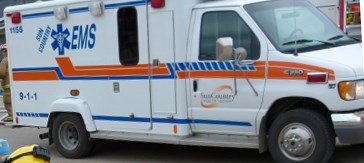There have been many improvements and upgrades to the level of service provided by the Emergency Medical Services in Sun Country Health Region, which provides ambulance service throughout the southeast corner of the province, Rotary Club members were told on Thursday.
The director of EMS for Sun Country, Charles Eddy, spoke to the club about what services are offered, and what some of the challenges are that they face in providing these services.
In introducing Eddy, Myron Fletcher noted he first met him and Marcel Roy when they came to his then-privately operated ambulance service, which ran out of a garage across the street of the 7-Eleven store today, for a job. Today, Eddy is in charge of coordinating the ambulance services from 16 points in Sun Country, three of them privately-run, including Carlyle, Fillmore and Stoughton.
They operate 20 ambulances altogether with a $6 million budget, with 140 personnel, put on some 240,000 kilometres a year and handle 4,700 calls each year.
“That’s a relatively low call volume compared to some jurisdictions,” said Eddy, adding that amongst the personnel are 10 advanced care paramedics (ACPs), including two in Weyburn, five in Estevan, one in Kipling and one in Oxbow.
“This is the highest level of training that you can attain, and having 10 ACPs is a feather in our cap,” said Eddy, pointing out part of the reason is the support given by the Sun Country Health Region, such as for bursaries for the training, and helping to retain these people here.
By comparison, he said, when he started “back in the day”, a person didn’t have to be an EMT to work for the ambulance service.
A challenge for the EMS service today is, “the dynamics in rural areas are different now. You used to have a lot of volunteers in rural areas. It’s 24-hour coverage seven days a week, so it’s a struggle just like it is to recruit nurses for rural areas,” said Eddy, adding there are 60 First Responders in Sun Country, who are particularly crucial in remote rural communities where it may take some time for an ambulance to be dispatched.
“These are true heroes in our system,” said Eddy.
The ambulances themselves have changed a lot, Eddy noted, as “back in the day”, an ambulance could be put together for maybe $20,000, while today an ambulance unit can run $130-140,000, and carry enough equipment like they're taking the emergency room out to the site where the response is needed.
The level of service that EMS provides is also far beyond what it used to be, as today they can respond to anything from asthma problems to drug overdoses, to the use of CPAP (continuous air pressure) if a person has moisture in their lungs, to dealing with strokes and heart attacks, and ACPs can do chest decompressions.
“Even though we do more, there are still a lot of scoop and run calls,” said Eddy, noting the protocol for strokes right now is to take them straight to Regina for immediate treatment rather than bringing them first to the Weyburn hospital.
In regards to strokes, Eddy also noted the ambulance have “FAST” stickers to educate the public on the signs of a stroke. F is for facial, where you get a suspected stroke victim to try and smile. A is for arms, where you see if they can lift them. S is for speech, as it often becomes slurred with a stroke, and T means “time to call 911” if it appears the person has had a stroke.
“We want the public to be aware of these signs,” said Eddy.
People also need to be aware that ambulance services are not insured by medicare, and can be very expensive. Eddy noted a ride from Coronach into Regina can cost $1,500, and the basic charge to call STARS air ambulance out is $450.



